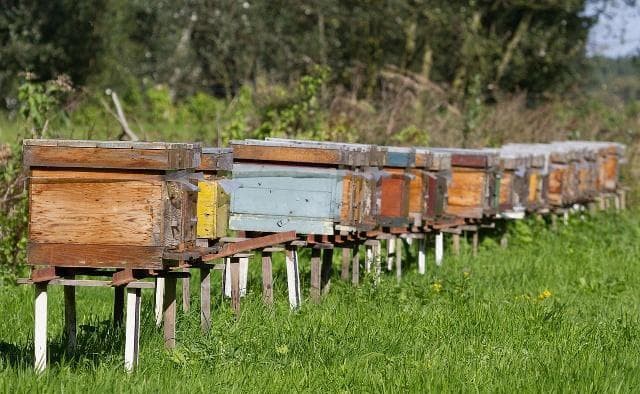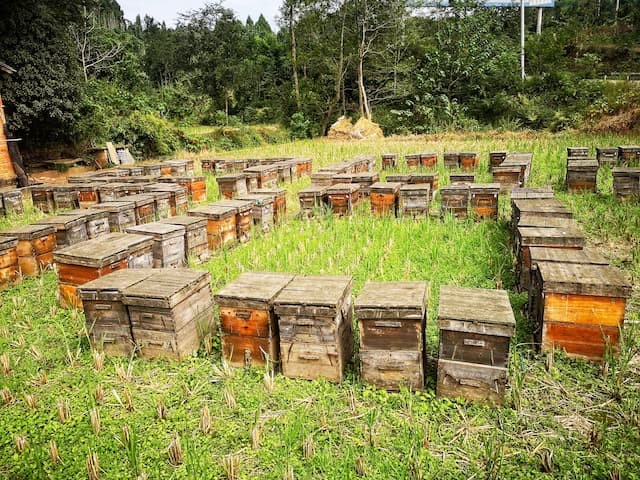The placement of our hives is critical to the quality and quantity of the honey we produce. The location must have ample sunlight and be away from any possible sources of contamination. We must also consider the flow of the land, as the bees will need access to a water source. Once we have found the perfect spot for our hives, we will need to ensure that the area is clear of any obstacles.
Bees are vital to the ecosystem and without them, many plants would not be able to reproduce. For this reason, it is important to place bee hives in an area with a variety of flora. By doing this, we ensure that the bees have access to the pollen and nectar they need to survive and thrive.
When the weather is warm, we tend to spend more time outdoors and often look for areas in the shade to relax in.During the winter months, we often seek out sunny spots that are well drained and protected from strong winds. This preference may be due to the fact that we are trying to maximize our exposure to sunlight in order to help us stay warm.
You should not place your hive on the ground for a number of reasons. First, ground moisture can seep into the hive and affect the health of your bees. Second, if the hive is on the ground, it is more likely to be disturbed by animals or other people. third, if the hive is on the ground, it is more likely to get wet during rainy weather, which can lead to mold or other problems. fourth, if the hive is on the ground, it is more likely to be damaged if something falls on it. Finally, hives that are on the ground are more likely to be stolen.

Most beekeepers choose to place their hives on a gentle slope, as this provides good drainage and prevents the hives from getting too wet. However, some beekeepers place their hives on old large truck wheels. This helps to keep the hives off the ground and allows the bees to move around more easily.
At our apiary, we take pride in the cleanliness of our hives and the health of our bees. We never place our hives near the hives of other apiarists or near farms that are often heavily sprayed with pesticides. Our hives are constructed so that they can be easily cleaned and inspected, and we use only organic materials in their construction. Our bees have access to plenty of fresh water and a variety of flowers, and we make sure to rotate their pasture so they always have plenty to eat. By following these practices, we ensure that our bees are healthy and productive, and our honey is of the highest quality.
An apiary is a collection of bee hives, usually in an open area such as a field or pasture. In order to have sufficient production, we may not have a fixed place for our apiary. We may have to move the hives around to different locations depending on the time of year and the availability of resources.
The hives may have to be moved 2 times a year in areas with flowering. This is because the bees will go to the flowers to collect nectar and pollen. The hives should be moved to a spot that is near the flowers so the bees can easily get to them.
When you transfer hives, be sure to choose a spot at least 3 miles (4,8 km) away from the initial location. If you do not apply reorientation measures, the foraging bees can get confused and return to the initial place. Ask local experts for advice on the best way to transfer hives.
When choosing a location to place your beehive, there are several things you need to take into account. One of the most important factors is the proximity to a water source. Honeybees need to have access to water in order to survive and thrive, so the location you choose must have a natural or artificial water source at a close distance. Other factors to consider include the amount of sun exposure and the type of terrain.
The classification of our honey will be determined by the plant (or the combination of plants) that prevails in the place where we will place the hives.
Each area has a different type of honey based on the major plant. For example, orange honey comes from an area with a lot of orange trees, while fir honey comes from an area with a lot of fir trees. This is why we distinguish the honey based on the major plant of the area.
In order to harvest orange honey, we need to place our hives close to a large number of orange trees so the bees will primarily forage on the orange blossoms. If there are not enough orange trees in the area, the bees will forage on a variety of other flowers and the honey will not have a strong orange flavor.
We place our beehives in the center of an orange orchard during the period of the orange trees’ flowering. This ensures that the bees have plenty of flowers to forage from and that the honey they produce is infused with the delicate flavor of orange blossoms. The size of the orchard is important, as the bees need a large area of flowers in order to gather enough nectar to make a significant amount of honey.
Wildflower honey is honey that is collected from different flowers, rather than just one type. This gives the honey a unique flavor that is different from other types of honey.Wildflower honey is a good choice for those who are looking for a honey that has a different flavor.
Bees are attracted to these plants because of the high concentration of nectar in the flowers. Nectar is a sugary substance that bees collect and use to make honey. The high concentration of nectar in these flowers makes them ideal for bee collection.

